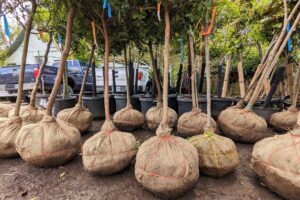Tag: Health
The Lifesaving Potential of Trees
A new scientific study associates tree planting with fewer deaths
At Friends of Trees, we champion the many benefits of urban trees: they clean the air and water, provide wildlife habitat, and shade our homes and streets. Trees improve our environment, but they also improve our quality of life. Dr. Geoffrey Donovan, a researcher with the United States Forest Service, wanted to investigate one step further — do trees save lives?
In 2013, Donovan conducted a study that associated a loss of trees from emerald ash borer with a higher rate of mortality for people that lived in those places that lost trees.
“I wanted to see if the inverse was true,” Donovan says. “Would planting more trees be associated with fewer deaths?”
Luckily, Donovan had access to years worth of tree planting data from Friends of Trees. Specifically, he used the planting data from the nearly 50,000 trees that Friends of Trees planted in Portland neighborhoods since 1990.
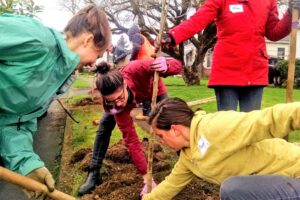
The new study, published in December 2022 in the journal Environmental International, found that each tree planted was associated with significant reductions in non-accidental and cardiovascular mortality. To account for other possible explanations for the mortality rate like race, education, and income, the statistical models incorporated data from the American Community Survey.
Looking at all 140 census tracts in Portland, Donovan showed that on average, 11.7 new trees in each neighborhood were associated with 15.6 fewer non-accidental deaths and five fewer cardiovascular deaths each year.
“It’s incredible,” says Friends of Trees Executive Director Yashar Vasef. “We know that trees can transform a community, but it’s really meaningful to see the data analysis.”
As the trees mature, their benefit grows too. Trees planted within the past 11-15 years had twice the impact of trees planted within the last five.
“The association is unequivocal, but the study has its limitations,” Donovan says. The study stops short of proving a definitive causal relationship between planting trees and fewer deaths, but Donovan expressed confidence in his findings, saying, “we do think it’s likely that trees are saving lives in Portland, because we accounted for a lot of other explanations.”
One way the study was able to account for other explanations was by focusing on the change in trees compared to the change in mortality rate. The totality of canopy can vary widely by neighborhood, but each new tree can make a difference regardless of where it’s planted.
The study went on to associate the reduced death rate with an incredible economic benefit, based on the EPA’s statistical value of a human life. Planting one tree in each of the 140 census tracts in Portland is associated with a reduction in non-accidental death of 1.33, which has a statistical value of $14.2 million. To plant and care for those 140 trees would cost just $3,000-$13,000.
“In short, trees are cheap and human lives are valuable,” Donovan says. “The public money that went to Friends of Trees generated remarkable rates of return.”
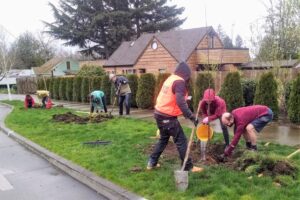
The City of Portland’s Bureau of Environmental Services did not renew its partnership with Friends of Trees that added 40,000 street and yard trees in Portland over 14 years. Friends of Trees is still planting in Northeast Portland as part of the Clean Air Canopy project, and in 17 municipalities throughout Western Oregon and Southwest Washington.
“Beyond the incredible findings, this study points to the importance of robust data collection,” Yashar says. “By diligently tracking this information, we are creating huge data sets that scientists can use in their research. And then that research can help us do our work better.” Friends of Trees logs the location, species, and planting date of every tree it plants.
“Friends of Trees data has been enormously helpful to me,” Donovan says. “I would love to see even closer collaboration between practitioners and scientists.”
Improving Air Quality in Eugene
How trees can help address winter inversions
Residents of Eugene and Springfield are very familiar with inversions. On a cold, clear winter day, pollutants get trapped in the valley, hanging low like a fog and causing notably poor air quality for people on the ground.
“On a cold, dry day, you can pretty much expect an inversion,” says Friends of Trees Eugene Director Erik Burke. “It’s not uncommon to see air quality alerts in winter.”
In the Eugene metro area, the main culprits are car emissions and wood smoke. Particulates in the air get trapped in the valley by warmer air above. It can lead to uncomfortable and even dangerous levels of air pollution. Because Eugene is at the southern end of the Willamette Valley and further away from winds coming from the Columbia River, it’s more susceptible to inversions than the Portland metro region.
One thing that can help? You guessed it, more trees! Trees improve air quality by providing surface area for airborne particulates to stick to. Those particulates are then washed by rain into the soil, where microorganisms break them down into something less harmful.
By breaking down pollutants, soil functions like a kidney of sorts. Trees help guide and slow water through the soil, making trees huge contributors to both air and water quality in both natural and urban environments. As Erik puts it, “trees are stormwater facilities.”
Like in plenty of other cities, the neighborhoods that are closest to polluters in Eugene are low income neighborhoods. Air quality is one of the many benefits of trees that low-canopy neighborhoods are deprived of. Friends of Trees plantings in the Bethel neighborhood are in part to address air quality concerns there.
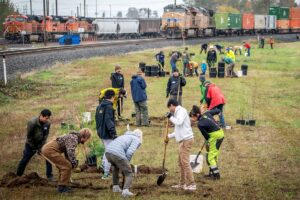
“All trees are good at improving air quality,” Erik says. “We’re trying to get trees in the ground where air quality is worst.”
This is one of the reasons Friends of Trees plants along the railyard and the Northwest Expressway, where idling locomotives and automobiles are releasing particulates.
While all trees improve air quality, evergreens are particularly useful because they keep their leaves or needles all year.
“Most of our rain comes in winter,” Erik says, “so evergreens are essential. We have a lot to learn about evergreens and air quality.”
Most of the evergreens in Eugene’s urban forest are conifers rather than broadleaf evergreens. While we often think of conifers when we think of evergreens, other species like California live oaks, holm oak and California bay laurel also keep their leaves year-round. Many evergreens grow to be quite large, so the Eugene team is looking to incorporate smaller evergreens like toyon into their plantings.
Clean Air & Community in Cully
NE Portland neighborhoods come together to plant for environmental justice
Earlier this month, 110 volunteers gathered in the Cully neighborhood in Northeast Portland for the first planting of our Clean Air Canopy project. The first volunteers to arrive to a planting event are the staging volunteers, who organize tools and trees for all the crews. At Cully, all of the staging volunteers were also treecipients—they’d have their own tree planted in their yard as part of the day’s activities. They were so excited to help, to get to know each other, and to help get trees planted, not just in their own yard but in their community.
“There was a lot of camaraderie from the get-go,” said Neighborhood Trees Senior Specialist Litzy Venturini. “It was a really positive morning with great energy from the moment I got there.”
This Clean Air Canopy project is the result of an Oregon Department of Environmental Quality lawsuit against a polluter in the neighborhood. The DEQ fined the facility and granted funds to Friends of Trees and our partners to lead community tree plantings in the area. This project would not be possible without our partners: Verde, the Cully Air Action Team (CAAT), and the Cully Association of Neighbors. Verde and CAAT’s advocacy work held this polluter accountable and led to this project’s creation.
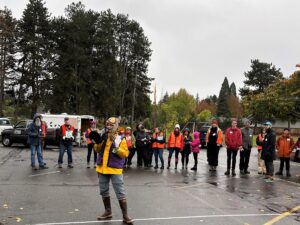
“Polluted air and water are one of the biggest environmental injustices we face,” says Neighborhood Trees Senior Specialist Andrew Land. “Tree planting is among the most instant-impact civic actions you can perform.”
That sentiment was shared among volunteers, who were grateful to turn this negative—pollution—into a positive thing for their neighborhood. Volunteer crews planted 100 trees, and 31 different species of trees.

“Diversity in nature equates to resilience,” Andrew says. “Isolated species are very vulnerable in nature. If a pest or disease in the future attacks one of the species we’ve planted, we’ll still have many more out there to continue protecting us from air pollution from off highways.”
A special aspect to the day was that we had an entirely Spanish-speaking crew, led by Friends of Trees Field Tech Manuel Ku. That crew consisted of Los Líderes Verdes, who were training to become crew leaders themselves as part of our collaboration with Verde.
“It was a great day,” Litzy said. “There was that community feeling that makes events so special.”
Learn how trees help make us healthy
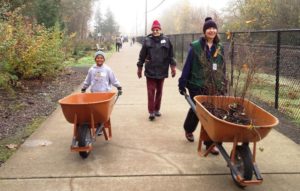 Do you know how increased exposure to nature creates countless health benefits?
Do you know how increased exposure to nature creates countless health benefits?
Join us for a free Trees & Health event–in Portland, Salem and Eugene
Trees benefit people, creatures and the planet in ways too numerous to list here. We know that trees combat climate change, clean our air and water, create habitat, grow food … Trees do so much that it’s no surprise that trees improve our health, too—but it’s only relatively recently that we’ve learned just how much trees contribute to human health. Friends of Trees is now using that knowledge to implement programming specific to trees and health.
Thanks to a 2016 funding award from Metro, Friends of Trees has expanded our community tree-plantings to include Portland’s Northwest Industrial District, focusing on projects to directly impact human health. Our goal is adding green infrastructure to this area that has an abundance of concrete and a dearth of green. These plantings will also forge a stronger connection between the Industrial District and Forest Park, which is so close yet so disconnected from this part of town; adding trees in the industrial section contributes to a green corridor, channeling the benefits of the park to the industrial district.
How do trees make us healthy? Patients in hospitals heal more quickly if they have a view of trees and nature; people are more likely to get out and walk and run through tree-lined communities; babies in tree-lined neighborhoods are more likely to have a healthy birth weight; exposure to greenspaces can reduce blood pressure and stress levels; views of natural settings have been found to reduce crime and aggression … to list just a few.
Yes, the trees we plant here will improve our health, but so will the way we plant those trees. Our community tree-planting program is implemented with thousands of volunteers, many of whom have never volunteered before. And guess what? Volunteering is good for your health, too! Volunteering makes us happy, contributes to more satisfied employees, decreases the risk of depression, reduces stress levels, and more!
And to help these trees grow and thrive, Friends of Trees will water, mulch and prune these new trees for their first two years in the ground. This is slow and steady work, and we are excited to continue growing this program over time.
There’s another component to this project: Scientists. Presentations by experts are a part of our Trees and Health work. It’s an exciting time, with new research coming out regularly, and we look forward to sharing this important information with our community.
Learn more about trees and health.
JOIN US FOR A FREE TREES & HEALTH EVENT
Guest lecturer Dr. Kathy Wolf of the University of Washington explores how nearby nature improves environmental, social, and economic conditions in cities
- Portland, March 1, 6-7:30 p.m.
- Salem, March 2, 6-7:30 p.m.
- Eugene, March 3, 5:30-7:00 p.m.
Location and registration information.
This is an excerpt from our February Treemail, read the entire issue here.
Community Nature Walks: Celebrating trees and health!
By Erica Timm

What do trees, walking and socializing with friends and neighbors all have common? Well, they’re all good for your health!
We couldn’t think of a better way to celebrate Arbor Month than to host a Community Nature Walk in a few communities around Portland this month. Check the list below to find the one fits your schedule best:
- Boise-Eliot Neighborhood: Thursday, April 9th at 1 p.m. meeting at Lot 13 (4009 N Mississippi Ave) – map
- Lents Neighborhood: Wednesday, April 15th at 6 p.m. meeting at the Lents Tool Library (9211 SE Ramona St) – map
- Portsmouth Neighborhood: Saturday, April 25th at 10 a.m. meeting at the N Houghton-Fortune intersection – map
These walks bring folks together for an hour long walking conversation about the neighborhood nature gems we’ll discover along the way and other related tree topics. Some highlights may include a wishing tree, a topiary animal hedge, a community orchard, a healing garden and more…
Join us for a walk, or all three, to learn more about Portland’s neighborhood nature gems!
For more information, contact Erica at [email protected] or 503-467-2533.
For more information on the many health benefits of trees, visit the Green Cities: Good Health website.
Erica Timm is a Senior Neighborhood Trees Specialist

